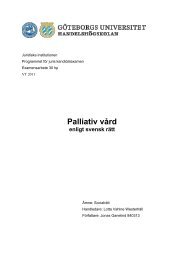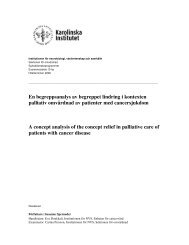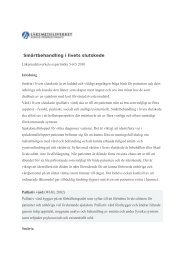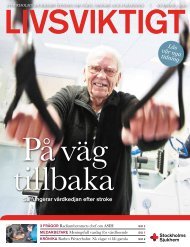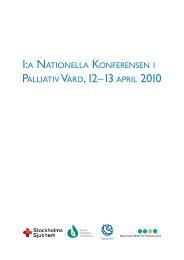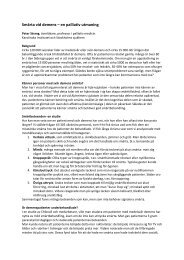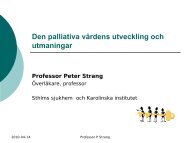Physiotherapy in palliative careâ - Stockholms sjukhem
Physiotherapy in palliative careâ - Stockholms sjukhem
Physiotherapy in palliative careâ - Stockholms sjukhem
You also want an ePaper? Increase the reach of your titles
YUMPU automatically turns print PDFs into web optimized ePapers that Google loves.
ForewordPalliative care is good care at the end of life with the goal to give the best possible quality oflife to patients and their family. We who are work<strong>in</strong>g <strong>in</strong> <strong>palliative</strong> care th<strong>in</strong>k this is obvious.But what are the characteristics of good care at the end of life and what are the criteria? Howcan we know that what we do for patients and their families is most adequate and even mostcost effective?Most patients at the end of life are cared for with<strong>in</strong> primary health care, nurs<strong>in</strong>g homes and <strong>in</strong>hospitals. Many are also cared for with<strong>in</strong> specialized <strong>palliative</strong> care, <strong>in</strong> hospices and <strong>palliative</strong>care units as well as <strong>in</strong> specialized home care. Specialized <strong>palliative</strong> care is team-based andconsists of physicians and nurses but often also <strong>in</strong>clude assistant nurses, physiotherapists, socialworkers and occupational therapists and sometimes also a priest, a deacon and a dietician.The physiotherapist’s special competency <strong>in</strong> the <strong>palliative</strong> team emerges clearly <strong>in</strong> this cl<strong>in</strong>icalhandbook which firstly is aimed at physiotherapists car<strong>in</strong>g for severely ill and dy<strong>in</strong>g patients.But the handbook will also provide important <strong>in</strong>formation about physiotherapist work <strong>in</strong><strong>palliative</strong> care for other professions. As far as we know this is the first Swedish textbook onphysiotherapy <strong>in</strong> <strong>palliative</strong> care.Most of the symptoms and problems physiotherapists meet <strong>in</strong> cl<strong>in</strong>ical everyday life arerepresented <strong>in</strong> the handbook. Knowledge, both scientific as well as the experience-based, isdescribed and are the basis for suggested <strong>in</strong>terventions and treatments.We know thorough scientific studies for common physiotherapeutic treatments are lack<strong>in</strong>g,especially <strong>in</strong> <strong>palliative</strong> care. An <strong>in</strong>ventory of the most important pitfalls <strong>in</strong> knowledge should bethe basis for plann<strong>in</strong>g future research <strong>in</strong> physiotherapy <strong>in</strong> <strong>palliative</strong> care.We hope this handbook will be useful for the education of physiotherapists as well as areference book for physiotherapists meet<strong>in</strong>g and treat<strong>in</strong>g patients at the end of life.Stockholm September 2009Carl Johan FürstSenior consultantPalliative Centre<strong>Stockholms</strong> Sjukhem FoundationSylvia SauterRPT /Coord<strong>in</strong>atorPalliative Centre<strong>Stockholms</strong> Sjukhem Foundation<strong>Physiotherapy</strong> <strong>in</strong> <strong>palliative</strong> care – a cl<strong>in</strong>ical handbook Ulla Frymark, Lilian Hallgren, Ann‐Charlotte Reisberg 4



